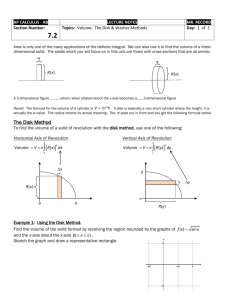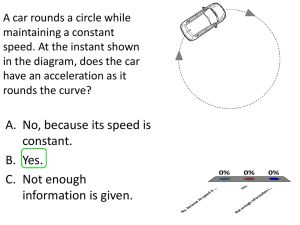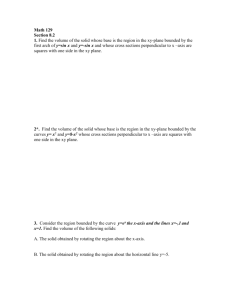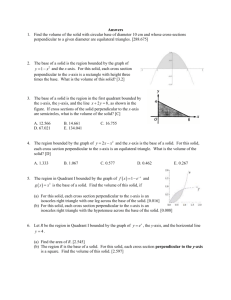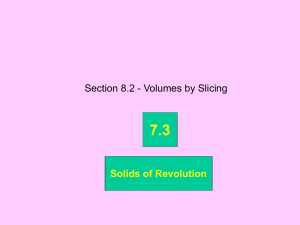click - Uplift Education
advertisement
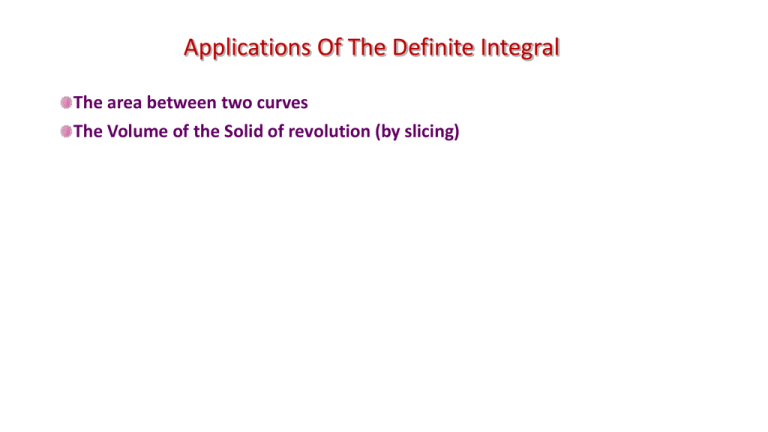
Applications Of The Definite Integral The area between two curves The Volume of the Solid of revolution (by slicing) AREA BETWEEN CURVES AREA BETWEEN CURVES 𝑑𝐴 = 𝑏 𝐴= 𝑏 𝑑𝐴 = 𝑎 𝑜𝑢𝑡𝑒𝑟 𝑖𝑛𝑛𝑒𝑟 − 𝑓𝑢𝑛𝑐𝑡𝑖𝑜𝑛 𝑓𝑢𝑛𝑐𝑡𝑖𝑜𝑛 𝑑 𝑦1 𝑥 − 𝑦2 (𝑥) 𝑑𝑥 𝑎 dx 𝐴= 𝑑 𝑑𝐴 = 𝑐 𝑥1 𝑦 − 𝑥2 (𝑦) 𝑑𝑦 𝑐 Determine the area of the region bounded by y = 2x2 +10 and y = 4x +16 between x = -2 and x = 5 𝑏 𝐴= 𝑏 𝑑𝐴 = 𝑎 𝑎 𝑜𝑢𝑡𝑒𝑟 𝑖𝑛𝑛𝑒𝑟 − 𝑓𝑢𝑛𝑐𝑡𝑖𝑜𝑛 𝑓𝑢𝑛𝑐𝑡𝑖𝑜𝑛 𝑑𝑥 Determine the area of the region enclosed by y = sin x and y = cos x and the y -axis for 0 ≤ 𝑥 ≤ 𝜋 2 . 1 Determine the area of the enclosed area by 𝑥 = 2 𝑦 2 − 3 and 𝑦 = 𝑥 − 1 Intersection: (-1,-2) and (5,4). 𝑏 𝐴= 𝑏 𝑑𝐴 = 𝑎 𝑎 𝑜𝑢𝑡𝑒𝑟 𝑖𝑛𝑛𝑒𝑟 − 𝑓𝑢𝑛𝑐𝑡𝑖𝑜𝑛 𝑓𝑢𝑛𝑐𝑡𝑖𝑜𝑛 𝑑𝑥 1 THE SAME: Determine the area of the enclosed area by 𝑥 = 2 𝑦 2 − 3 and 𝑦 = 𝑥 − 1 Intersection: (-1,-2) and (5,4). 𝑑 𝐴= 𝑑 𝑑𝐴 = 𝑐 𝑐 𝑜𝑢𝑡𝑒𝑟 𝑖𝑛𝑛𝑒𝑟 − 𝑓𝑢𝑛𝑐𝑡𝑖𝑜𝑛 𝑓𝑢𝑛𝑐𝑡𝑖𝑜𝑛 𝑑𝑦 So, in this last example we’ve seen a case where we could use either method to find the area. However, the second was definitely easier. Intersection points are: y=-1 y=3 3 −𝑦 2 + 10 − 𝑦 − 2 𝐴= 2 𝑑𝑦 −1 3 −2𝑦 2 + 4𝑦 + 6 𝑑𝑦 = −1 3 2 3 2 = − 𝑦 + 2𝑦 + 6𝑦 3 −1 𝐴= 64 3 Volume of REVOLUTION Find the Volume of revolution using the disk method Find the volume of revolution using the washer method Find the volume of revolution using the shell method Find the volume of a solid with known cross sections Area is only one of the applications of integration. We can add up representative volumes in the same way we add up representative rectangles. When we are measuring volumes of revolution, we can slice representative disks or washers. These are a few of the many industrial uses for volumes of revolutions. 𝑛 𝑏 𝑉= 𝑑𝑉 = 𝜋𝑟 2 𝑑𝑥 𝑑𝑉 𝑉 = lim ∆𝑥→0 𝑎 𝑛 𝑖=1 𝑓(𝑥) 𝑎 𝑏 𝑥 𝑑𝑉 = π 𝑓 𝑥 2 𝑑𝑥 𝑓(𝑥) 𝑥 𝑎 𝑦 = −𝑘 𝑏 𝜋𝑟 2 ∆𝑥 ∆𝑉𝑖 = lim 𝑑𝑉 = π 𝑓 𝑥 + 𝑘 2 𝑑𝑥 ∆𝑥→0 𝑖=1 𝑓(𝑥) 𝑦=𝑘 𝑎 𝑏 𝑥 𝑦=𝑘 𝑑𝑉 = π 𝑘 − 𝑓 𝑥 𝑓(𝑥) 𝑎 𝑑𝑉 = π 𝑓 𝑥 − 𝑘 2 𝑑𝑥 𝑏 𝑥 2 𝑑𝑥 𝑑 𝑉= 𝑑𝑉 𝑐 𝑥 = −𝑘 𝑑 𝑥(𝑦) 𝑐 𝑑 𝑥=𝑘 𝑥(𝑦) 𝑐 𝑑 𝑥=𝑘 𝑥(𝑦) 𝑐 𝑑 𝑐 𝑥(𝑦) 𝑦 𝑑𝑉 = π 𝑥 𝑦 2 𝑑𝑦 𝑑𝑉 = π 𝑥 𝑦 + 𝑘 2 𝑑𝑦 𝑑𝑉 = π 𝑥 𝑦 − 𝑘 2 𝑑𝑦 𝑑𝑉 = π 𝑘 − 𝑥 𝑦 2 𝑑𝑦 A solid obtained by revolving a region around a line. A=𝜋 𝑜𝑢𝑡𝑒𝑟 𝑟𝑎𝑑𝑖𝑢𝑠 2 𝑖𝑛𝑛𝑒𝑟 − 𝑟𝑎𝑑𝑖𝑢𝑠 NOTE: Cross-section is perpendicular to the axis of rotation. 2 𝑦1 (𝑥) 𝑦2 (𝑥) 𝑏 𝑎 𝐴 𝑑 𝑏 𝑥 𝑐 2 − 𝑦2 𝑥 2 𝑑𝑥 𝑉= 𝑑𝑉 𝑑𝑉 = 𝐴 𝑑𝑥 𝑎 𝑥2 (𝑦) 𝑥1 (𝑦) 𝐴 𝑑𝑉 = π 𝑦1 𝑥 𝑑 𝑑𝑉 = π 𝑥1 𝑦 2 − 𝑥2 𝑦 2 𝑑𝑦 𝑉= 𝑑𝑉 𝑐 𝑑𝑉 = 𝐴 𝑑𝑦 Example: Find the volume of the solid formed by revolving the region bounded by y = x and y = x² over the interval [0, 1] about the x – axis. 1 𝑉=𝜋 𝑥 2 − 𝑥2 0 1 𝑥 − 𝑥 4 𝑑𝑥 𝑉=𝜋 0 𝑥2 𝑥5 𝑉=𝜋 − 2 5 3 𝑉= 10 1 0 2 𝑑𝑥 Example: rotate it around x = axis Volumes by Cylindrical Shells Summing up the volumes of all these infinitely thin shells, we get the total volume of the solid of revolution: 𝑏 A = 2𝜋 𝑟 ℎ = 2𝜋 𝑥 ℎ 𝑑𝑉 = 𝐴 𝑑𝑥 = 2𝜋 𝑥 ℎ 𝑑𝑥 𝑉= 𝑑𝑉 𝑎 𝑦(𝑥) 𝐴 𝑑𝑉 = 𝐴 𝑑𝑥 = 2𝜋 𝑥 𝑦 𝑥 𝑑𝑥 𝑏 𝑎 𝑉 = 2𝜋 𝑏 𝑎 𝑑𝑉 = 𝐴 𝑑𝑥 = 2𝜋 𝑥 𝑦1 (𝑥) − 𝑦2 (𝑥) 𝑑𝑥 𝑦1 (𝑥) 𝐴 𝑥 𝑦 𝑥 𝑑𝑥 𝑏 𝑦2 (𝑥) 𝑉 = 2𝜋 𝑥 𝑦1 (𝑥) − 𝑦2 (𝑥) 𝑑𝑥 𝑎 𝑎 𝑏 Example : Find the volume of the solid of revolution formed by rotating the region bounded by the xaxis and the graph of 𝑦 = 𝑥 from x = 0 to x =1, about the y - axis. 1 𝑉 = 2𝜋 𝑥 𝑥𝑑𝑥 0 2 5/2 𝑉 = 2𝜋 𝑥 5 4𝜋 𝑉= 5 1 0 Example: Find the volume of the solid of revolution formed by rotating the finite region bounded by the graphs of 𝑦 = 𝑥 − 1 and 𝑦 = (𝑥 − 1)2 about the y-axis. 2 2 𝑉 = 2𝜋 𝑥 𝑥 − 1 − (𝑥 − 1)2 𝑑𝑥 𝑉 = 2𝜋 𝑥(𝑥 − 1)2 𝑑𝑥 𝑥 𝑥 − 1𝑑𝑥 − 2𝜋 1 𝑉 = 2𝜋 x = 2 u=1 1 (𝑢 + 1)𝑢2 𝑑𝑥 (𝑢 + 1) 𝑢𝑑𝑥 − 2𝜋 0 x = 1 u=0 1 1 1 29 𝑉= 𝜋 30 2 u=x–1 x=u+1 du = dx 0 2𝑢5/2 2𝑢3/2 𝑢4 𝑢3 1 2 2 1 1 𝑉 = 2𝜋 + − − = 2𝜋 + − − 5 3 4 3 0 5 3 4 3 Time to Practice !!! AGAIN EXAMPLE Find the volume of the solid obtained by rotating the region bounded by 𝑦 = 𝑥 − 𝑥 3 and 𝑦 = 0 about the line 𝑥 = 2 One More Example http://mathdemos.org/mathdemos/sectionmethod/sectiongallery.html Procedure: volume by slicing o sketch the solid and a typical cross section o find a formula for the area, A(x), of the cross section o find limits of integration o integrate A(x) to get volume Find the volume of a solid whose base is the circle x2 + y2 = 4 and where cross sections perpendicular to the x-axis are all squares whose sides lie on the base of the circle. First, find the length of a side of the square the distance from the curve to the x-axis is half the length of the side of the square … solve for y x y 4 2 2 y 4x 2 y A rea 2 4x 2 2 44 x 16 4 x 2 2 4x length of a side is : 2 2 2 Volum e 16 4 x dx 2 2 2 4x 2 Find the volume of a solid whose base is the circle x2 + y2 = 4 and where cross sections perpendicular to the x-axis are all squares whose sides lie on the base of the circle. 𝑦 = 4 − 𝑥2 x2 + y 2 = 4 𝑎 = 2 4 − 𝑥2 𝐴 = 𝑎2 𝑑𝑉 = 𝐴 𝑑𝑥 2 𝑉 = 4 4− −2 𝑥2 128 𝑑𝑥 = 3 Find the volume of a solid whose base is the circle x2 + y2 = 4 and where cross sections perpendicular to the x-axis are all equilateral triangles whose sides lie on the base of the circle. 𝑑𝑉 = 𝐴 𝑑𝑥 𝑦 = 4 − 𝑥2 x2 + y 2 = 4 1 𝐴= 𝑎 2 𝐴 =? 𝑎2 𝑎 − 2 2 = 3 2 𝑎 = 3 4 − 𝑥2 4 2 𝑉= 3 4− −2 𝑥2 𝑑𝑥 = 32 3 ≈ 18.475 Find the volume of a solid whose base is the circle x2 + y2 = 4 and where cross sections perpendicular to the x-axis are all semicircles whose sides lie on the base of the circle. 𝐴 =? 𝑦 = 4 − 𝑥2 x2 + y 2 = 4 1 𝑎 𝐴= 𝜋 2 2 2 1 4 − 𝑥2 2 = 𝜋𝑎 = 𝜋 8 2 𝑑𝑉 = 𝐴 𝑑𝑥 2 𝑉= −2 4 − 𝑥2 16𝜋 𝜋 𝑑𝑥 = ≈ 16.755 2 3 Find the volume of a solid whose base is the circle x2 + y2 = 4 and where cross sections perpendicular to the x-axis are all Isosceles right triangles whose sides lie on the base of the circle. 𝐴 =? 𝑦 = 4 − 𝑥2 x2 + y2 = 4 𝑎 1 𝑎2 2 𝐴= 𝑎 = = 4 − 𝑥2 𝜋 2 tan 4 4 𝑑𝑉 = 𝐴 𝑑𝑥 2 𝑉= 4−𝑥 −2 2 32 𝑑𝑥 = ≈ 10.667 3
